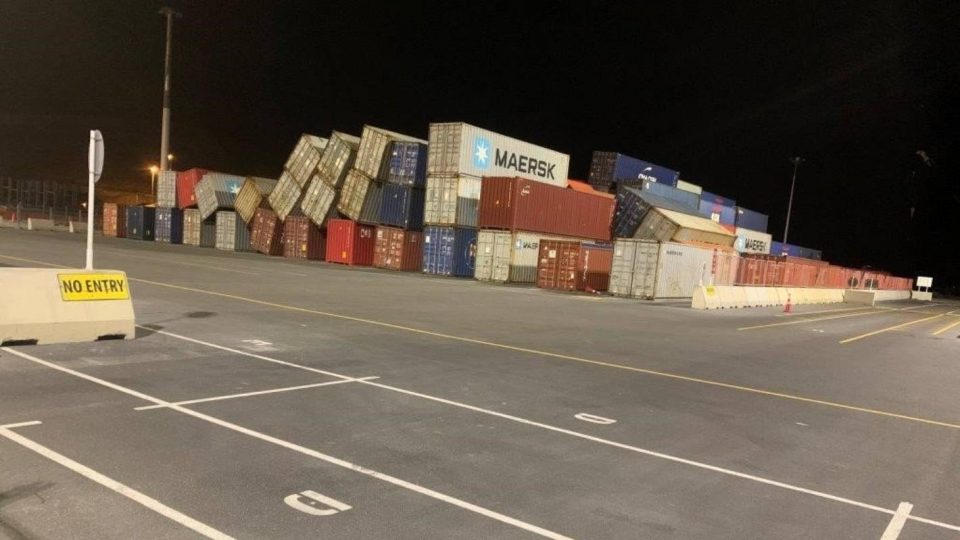On August 5, wind wreaked havoc on container stacks at the Port of Lyttelton, leaving 52 containers in a jumbled heap.
Two weeks earlier, at about 3.30am, an empty container blown off a stack at the port company’s city freight depot bounced over the boundary fence, and landed on the verge in Chapman’s Rd.
Neither of these incidents was reported to WorkSafe because no one was hurt, but port unions say it’s time to start logging them as near-misses.
They argue that towering piles of empty shipping containers pose a greater hazard as climate change whips up more extreme weather, and they want national stacking standards included in a wide-ranging review of port safety ordered after a spate of worker deaths.
READ MORE:
* Person dies after container incident at Ports of Auckland
* ‘Urgent need’ for inquiry into port safety following second death in a week
* Worker deaths spark 50 safety checks at port businesses
Google maps
The red circle marks where a container landed after being blown off a stack at Lyttelton Port Company’s city depot at 3.30am on July 21. The company says it was immediately retrieved by staff.
Three weeks ago gale force winds gusting up to 142kph blew 34 containers over at South Port in Bluff, but work had been suspended and no one was injured.
Ports of Auckland introduced a more sophisticated weather monitoring and alerting system after a freak tornado in June last year killed a mechanic working in the port’s Wiri freight hub, toppled containers, and left several yard workers severely shaken.
A check of stack heights and positioning by the National Institute of Water and Atmospheric Research concluded no changes were needed at the hub, and the port company says a WorkSafe investigation deemed the death of mechanic Janesh Prasad a “natural disaster fatality”.
Maritime Union of New Zealand (MUNZ) assistant secretary Craig Harrison is aware of 10 incidents involving fallen containers in the past year, mostly empties which each weigh between 4 and 6 tonnes, and can be stacked up to eight high.
RICKY WILSON/Stuff
Auckland Port Company has increased its weather monitoring after a tornado toppled contains at its Wiri freight hub last year.
He says containers are locked together on ships, but the practice of clamping containers together onshore stopped in the 1990s because it slowed down operations.
“The 40-foot ones fly more than the 20-foot ones due to their windage, they’re just empty and have a big sail, and because you have steel on steel, it just slides and that’s the problem.”
Practices between ports vary, with differing wind speed limits for crane and straddle operations, and a range of stack limits at coastal and inland freight hubs.
For example, at the Port of Tauranga container terminal, stacks are a maximum of three high, and general manager Blair Hamill says where possible, full containers are placed on top of empties to hold them down.
The Rail and Maritime Transport Union (RMTU) agrees a code of practice for container stacking is needed, and the issue was raised in a recent safety insights report it commissioned along with MUNZ, and government agency Maritime NZ.
LAWRENCE SMITH/STUFF
A person has died at the Ports of Auckland after falling from a container.
Lawyer Hazel Armstrong conducted in-depth interviews with 39 frontline workers from 10 ports, and she says substandard yard conditions, including container stacks and rutted, badly maintained surfaces, were identified as major safety risks, along with congestion and fatigue caused by poor rostering.
Armstrong points out that the number of shipping containers handled by New Zealand ports rose 50% to just over 2 million in the 10 years to 2019, but because ports were unable to expand their land area, that led to higher stacks of containers and more traffic management issues.
RMTU health and safety organiser Karen Fletcher says feedback from delegates indicated it was quite common for containers to blow around, and it was just accepted.
“That’s what happens when people become complacent to risky situations, because that’s just the way it’s always been, and when there’s no national standard, it’s just sort of ignored.”
Che baker/Stuff
Earlier this month gale force winds blew over 34 containers at Bluff. South Port chief executive Nigel Gear says it had one other incident in the past year when a container blew off a two-high stack after work was suspended, and in 2019, 13 containers were blown into the water.
Fletcher says the risk of a fatality is real, and in 2014 a hoist driver at Lyttelton Port’s inland port received serious back and head injuries when four containers on a poorly aligned stack fell and crushed the vehicle cab.
Falling containers do not meet WorkSafe’s reporting threshold unless someone is hurt, so the agency was not told of the 52-container pile up at Lyttelton.
However, just four days earlier WorkSafe was notified of concerns about the height of Lyttelton container stacks and says it is assessing that report.
Further questions put to WorkSafe about action over container safety were treated as an Official Information Act request which remained unanswered by publication time.
supplied
Lyttelton Port says stack heights vary depending on wind direction and whether the ground surface is concrete or gravel. Pyramid stacks of empty containers are considered more stable in strong winds.
After the container bounced out of the city depot, Lyttelton Port reviewed stacking and wind protocols, and empties must now be at least three meters from the boundary.
A company spokesperson says it monitors wind speed closely, and in both recent cases of container blow-overs, work had ceased, and all personnel were out of the affected areas.
The national review of port safety has received feedback from almost 1600 workers, and a report is due to be presented to WorkSafe Minister Michael Wood next month.


